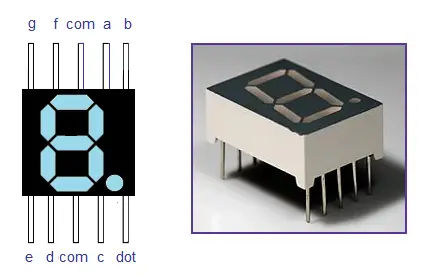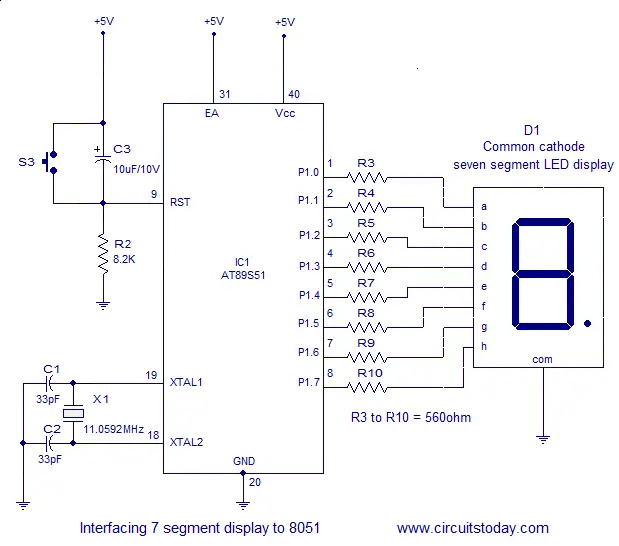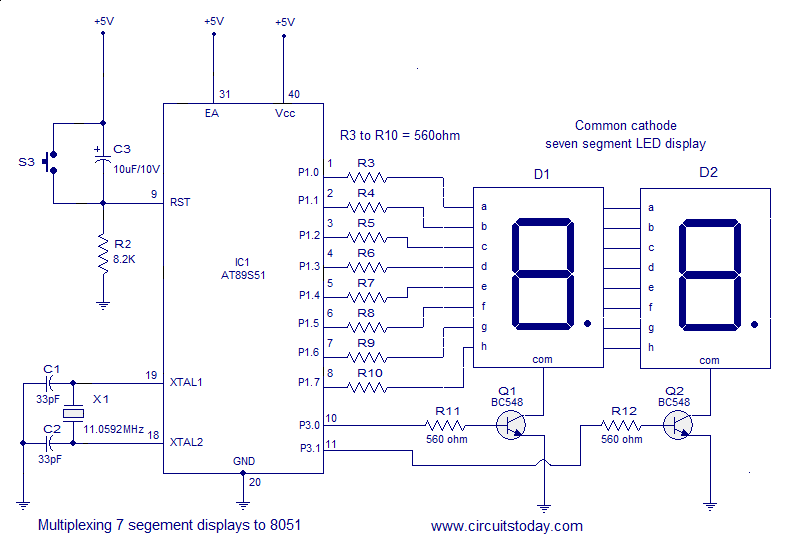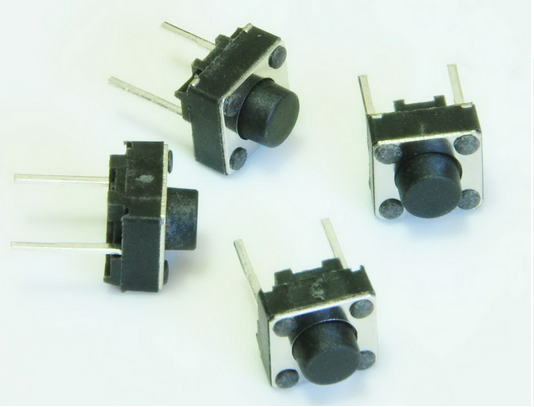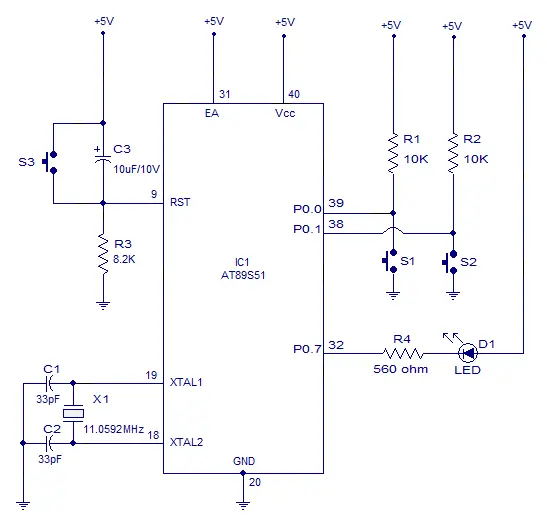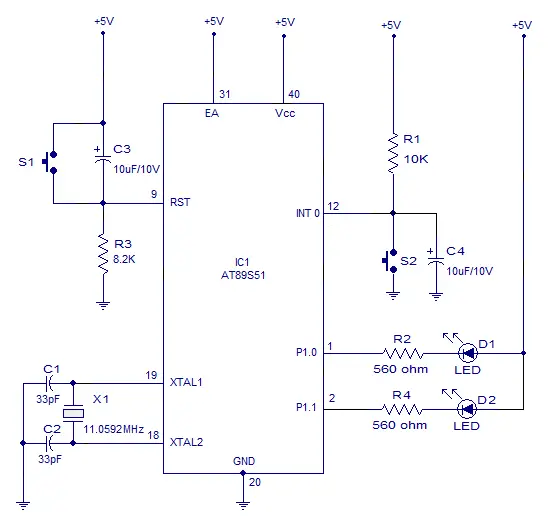A Note about 7 segment LED display.
This article is about how to interface a seven segment LED display to an
8051 microcontroller. 7 segment LED display is very popular and it can
display digits from 0 to 9 and quite a few characters like A, b, C, .,
H, E, e, F, n, o,t,u,y, etc. Knowledge about how to interface a seven
segment display to a micro controller is very essential in designing
embedded systems. A seven segment display consists of seven LEDs
arranged in the form of a squarish ’8′ slightly inclined to the right and a single LED as the dot character.
Different characters can be displayed by selectively glowing the required LED segments. Seven segment displays are of two types,common cathode and common anode. In common cathode type , the cathode of all LEDs are tied together to a single terminal which is usually labeled as ‘com‘ and the anode of all LEDs are left alone as individual pins labeled as a, b, c, d, e, f, g & h (or dot) . In common anode type, the anode of all LEDs are tied together as a single terminal and cathodes are left alone as individual pins. The pin out scheme and picture of a typical 7 segment LED display is shown in the image below.
Different characters can be displayed by selectively glowing the required LED segments. Seven segment displays are of two types,common cathode and common anode. In common cathode type , the cathode of all LEDs are tied together to a single terminal which is usually labeled as ‘com‘ and the anode of all LEDs are left alone as individual pins labeled as a, b, c, d, e, f, g & h (or dot) . In common anode type, the anode of all LEDs are tied together as a single terminal and cathodes are left alone as individual pins. The pin out scheme and picture of a typical 7 segment LED display is shown in the image below.
Digit drive pattern.
Digit drive pattern of a seven segment LED display is simply the different logic combinations of its terminals‘a’ to ‘h‘
in order to display different digits and characters. The common digit
drive patterns (0 to 9) of a seven segment display are shown in the
table below.
| Digit | a | b | c | d | e | f | g |
| 0 | 1 | 1 | 1 | 1 | 1 | 1 | 0 |
| 1 | 0 | 1 | 1 | 0 | 0 | 0 | 0 |
| 2 | 1 | 1 | 0 | 1 | 1 | 0 | 1 |
| 3 | 1 | 1 | 1 | 1 | 0 | 0 | 1 |
| 4 | 0 | 1 | 1 | 0 | 0 | 1 | 1 |
| 5 | 1 | 0 | 1 | 1 | 0 | 1 | 1 |
| 6 | 1 | 0 | 1 | 1 | 1 | 1 | 1 |
| 7 | 1 | 1 | 1 | 0 | 0 | 0 | 0 |
| 8 | 1 | 1 | 1 | 1 | 1 | 1 | 1 |
| 9 | 1 | 1 | 1 | 1 | 0 | 1 | 1 |
Interfacing seven segment display to 8051.
The circuit diagram shown above is of an AT89S51 microcontroller based 0
to 9 counter which has a 7 segment LED display interfaced to it in
order to display the count. This simple circuit illustrates two things.
How to setup simple 0 to 9 up counter using 8051 and more importantly
how to interface a seven segment LED display to 8051 in order to
display a particular result. The common cathode seven segment display D1
is connected to the Port 1 of the microcontroller (AT89S51) as shown in
the circuit diagram. R3 to R10 are current limiting resistors. S3 is
the reset switch and R2,C3 forms a debouncing circuitry. C1, C2 and X1
are related to the clock circuit. The software part of the project has
to do the following tasks.
- Form a 0 to 9 counter with a predetermined delay (around 1/2 second here).
- Convert the current count into digit drive pattern.
- Put the current digit drive pattern into a port for displaying.
All the above said tasks are accomplished by the program given below.
Program.
ORG 000H //initial starting address
START: MOV A,#00001001B // initial value of accumulator
MOV B,A
MOV R0,#0AH //Register R0 initialized as counter which counts from 10 to 0
LABEL: MOV A,B
INC A
MOV B,A
MOVC A,@A+PC // adds the byte in A to the program counters address
MOV P1,A
ACALL DELAY // calls the delay of the timer
DEC R0//Counter R0 decremented by 1
MOV A,R0 // R0 moved to accumulator to check if it is zero in next instruction.
JZ START //Checks accumulator for zero and jumps to START. Done to check if counting has been finished.
SJMP LABEL
DB 3FH // digit drive pattern for 0
DB 06H // digit drive pattern for 1
DB 5BH // digit drive pattern for 2
DB 4FH // digit drive pattern for 3
DB 66H // digit drive pattern for 4
DB 6DH // digit drive pattern for 5
DB 7DH // digit drive pattern for 6
DB 07H // digit drive pattern for 7
DB 7FH // digit drive pattern for 8
DB 6FH // digit drive pattern for 9
DELAY: MOV R4,#05H // subroutine for delay
WAIT1: MOV R3,#00H
WAIT2: MOV R2,#00H
WAIT3: DJNZ R2,WAIT3
DJNZ R3,WAIT2
DJNZ R4,WAIT1
RET
ENDAbout the program.
Instruction MOVC A,@A+PC is the instruction that produces the required
digit drive pattern for the display. Execution of this instruction will
add the value in the accumulator A with the content of the program
counter(address of the next instruction) and will move the data present
in the resultant address to A. After this the program resumes from the
line after MOVC A,@A+PC.
In the program, initial value in A is 00001001B. Execution of MOVC
A,@A+PC will add oooo1001B to the content in PC ( address of next
instruction). The result will be the address of command DB 3FH (line15)
and the data present in this address ie 3FH (digit drive pattern for 0)
gets moved into the accumulator. Moving this pattern in the accumulator
to Port 1 will display 0 which is the first count.
At the next count, value in A will advance to 00001010 and after the
execution of MOVC A,@+PC ,the value in A will be 06H which is the
digit drive pattern for 1 and this will display 1 which is the next
count and this cycle gets repeated for subsequent counts.
The reason why accumulator is loaded with 00001001B (9 in decimal)
initially is that the instructions from line 9 to line 15 consumes 9
bytes in total.
The lines 15 to 24 in the program which starts with command DB can be called as a Look Up Table (LUT).
Command DB is known as Define Byte – which defines a byte. This table
defines the digit drive patterns for 7 segment display as bytes (in hex
format). MOVC operator fetches the byte from this table based on the
result of adding PC and contents in the accumulator.
Register B is used as a temporary storage of the initial value of the
accumulator and the subsequent increments made to accumulator to fetch
each digit drive pattern one by one from the look up table(LUT).
Note:- In line 6,
Accumulator is incremented by 1 each time (each loop iteration) to
select the next digit drive pattern. Since MOVC operator uses the value
in A to fetch the digit drive pattern from LUT, value in ACC has to be
incremented/manipulated accordingly. The digit drive patterns are
arranged consecutively in LUT.
Register R0 is used as a counter which counts from 10 down to 0. This
ensures that digits from o to 9 are continuously displayed in the 7
segment LED. You may note lines 4, 11, 12, and 13 in the above program.
Line 4 initializes R0 to 10 (OAh). When the program counter reaches line
11 for the first time, 7 segment LED has already displayed 0. So we can
reduce one count and that is why we have written DEC Ro. We need to
continuously check if R0 has reached full count (that is 0). In order to
do that lines 12 and 13 are used. We move R0 to accumulator and then
use the Jump if Zero (JZ) instruction to check if accumulator has
reached zero. If Acc=0, then we makes the program to jump to START
(initial state) and hence we restart the 7 segment LED to display from 0
to 9 again. If Acc not equal to zero, we continue the program to
display the next digit (check line 14).
Multiplexing 7 segment display to 8051.
Suppose you need a three digit display connected to the 8051. Each 7
segment display have 8 pins and so a total amount of 24 pins are to the
connected to the microcontroller and there will be only 8 pins left with
the microcontroller for other input output applications. Also the
maximum number of displays that can be connected to the 8051 is limited
to 4 because 8051 has only 4 ports. More over three 3 displays will be
ON always and this consumes a considerable amount of power. All these
problems associated with the straight forward method can be solved by
multiplexing .
In multiplexing all displays are connected in parallel to one port and
only one display is allowed to turn ON at a time, for a short period.
This cycle is repeated for at a fast rate and due to the persistence of
vision of human eye, all digits seems to glow. The main advantages of
this method are
- Fewer number of port pins are required .
- Consumes less power.
- More number of display units can be interfaced (maximum 24).
The circuit diagram for multiplexing 2 seven segment displays to the 8051 is shown below.
When assembled and powered on, the circuit will display the number ’16′
and let us see how it is done. Initially the first display is activated
by making P3.0 high and then digit drive pattern for “1″ is loaded to
the Port 1. This will make the first display to show “1″. In the mean
time P3.1 will be low and so do the second display will be OFF. This
condition is maintained for around 1ms and then P3.0 is made low. Now
both displays will be OFF. Then the second display is activated by
making P3.1 high and then the digit drive pattern for “6″ is loaded to
the port 1. This will make the second display to show “6″. In the mean
time P3.0 will be low and so the second display will be OFF. This
condition is maintained for another 1ms and then port 3.1 is made low.
This cycle is repeated and due to the persistence of vision you will
feel it as “16″.
Transistor Q1 drives the first display (D1) and transistor Q2 drives the
second display (D2). R11 and R12 are the base current limiting
resistors of Q1 and Q2. The purpose of other components are explained in
the first circuit.
Program.
ORG 000H // initial starting address
MOV P1,#00000000B // clears port 1
MOV R6,#1H // stores "1"
MOV R7,#6H // stores "6"
MOV P3,#00000000B // clears port 3
MOV DPTR,#LABEL1 // loads the adress of line 29 to DPTR
MAIN: MOV A,R6 // "1" is moved to accumulator
SETB P3.0 // activates 1st display
ACALL DISPLAY // calls the display sub routine for getting the pattern for "1"
MOV P1,A // moves the pattern for "1" into port 1
ACALL DELAY // calls the 1ms delay
CLR P3.0 // deactivates the 1st display
MOV A,R7 // "2" is moved to accumulator
SETB P3.1 // activates 2nd display
ACALL DISPLAY // calls the display sub routine for getting the pattern for "2"
MOV P1,A // moves the pattern for "2" into port 1
ACALL DELAY // calls the 1ms delay
CLR P3.1 // deactivates the 2nd display
SJMP MAIN // jumps back to main and cycle is repeatedDELAY: MOV R3,#02HDEL1: MOV R2,#0FAHDEL2: DJNZ R2,DEL2DJNZ R3,DEL1RETDISPLAY: MOVC A,@A+DPTR // adds the byte in A to the address in DPTR and loads A with data present in the resultant addressRET
LABEL1:DB 3FH
DB 06H
DB 5BH
DB 4FH
DB 66H
DB 6DH
DB 7DH
DB 07H
DB 7FH
DB 6FH
END




